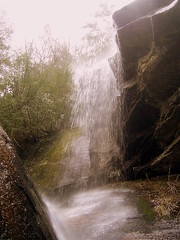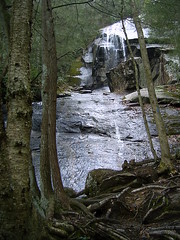2.25.2008
Jones Falls
WGS84
36.20277 -81.9825
36° 12.166'N 81° 58.95'W
36° 12' 10"N 81° 58' 57"W
17S 411676E 4006887N
36.20277 -81.9825
36° 12.166'N 81° 58.95'W
36° 12' 10"N 81° 58' 57"W
17S 411676E 4006887N
Epoch
When I visited Jones Falls yesterday, the word 'Epoch' kept came to mind. A gigantic boulder sits at the base of the upper falls where it fell at some point in the past. It seems to have the weight of geologic time.
Though it must have happened many many years ago, the stone looks as though it could have fallen recently. I wondered if anyone heard the incredible Crack! and Smash! it fell.
Though it must have happened many many years ago, the stone looks as though it could have fallen recently. I wondered if anyone heard the incredible Crack! and Smash! it fell.
2.23.2008
Hemlock Wooly Adelgid

Evidence of HWA infestation, Sill Branch.

It seems whenever hiking through a hemlock stand anymore one sees evidence of this infestation. It was so bad near Sill Branch Falls I mistook the occasional bits of white fluff falling through the air to be snow at first.
This from Save Our Hemlocks:
Hemlock Woolly Adelgid (Adeleges tsugae) is native to Asia where it is not a problem to native hemlocks. It was introduced to the United States in the 1920s to the Pacific Northwest, and in the early 1950s to the Washington DC and Richmond, Virginia areas. It lacks natural enemies in North America, so it has since spread throughout the eastern United States creating an extreme amount of damage to natural stands of hemlock, specifically eastern hemlock (Tsuga canadensis) and Carolina hemlock (Tsuga caroliniana).This from Wikipedia:
The hemlock woolly adelgid feeds on the phloem sap of tender Hemlock shoots. Unlike the balsam woolly adelgid that only attacked mature Balsam Fir, HWA infests all age classes of hemlock. In the northern portion of the Hemlock's range, death typically occurs four to ten years after infestation. Where Hemlock occurs in pure stands in that region, the most commonly observed tree species to succeed it is black (sweet) birch. In contrast, in the southern extreme of its range, Hemlock does not typically occur in pure stands but in linear riparian areas and other moist sites. Succession in these areas is vastly different for many reasons, one being the presence of Rhododendron maximum which often co-exists with hemlock, and due to a combination of influences, stricts regeneration to shade and otherwise understory-tolerant plant species. Major changes in ecosystem structure and function, including hydrologic processes, is expected with the loss of hemlock.There are efforts being made to try to prevent the spead of this insect and to possibly fight back using beetles and fungi.
Our forests have already suffered the loss of one great tree. The great chestnut forests are gone. All that remains of them are the occasional stump remnant, rotting trunk, immature sucker or barn siding. The loss of those trees to the blight was and still is a tragedy, but I never knew those forests. The forests I have known will be no more if the hemlocks are lost.
Sill Branch Falls
2.22.2008
Subscribe to:
Comments (Atom)
About Me
- Loki
- This blog is a work in progress. An ardent perambulator and nature enthusiast; I take pictures of what I see and post them here occasionally.
Blog Archive
- March 2013 (1)
- August 2012 (2)
- June 2012 (1)
- May 2012 (1)
- January 2012 (1)
- December 2011 (2)
- August 2011 (1)
- September 2010 (1)
- June 2009 (1)
- May 2009 (2)
- February 2009 (6)
- December 2008 (2)
- October 2008 (1)
- September 2008 (4)
- August 2008 (2)
- July 2008 (1)
- June 2008 (1)
- May 2008 (9)
- April 2008 (21)
- March 2008 (4)
- February 2008 (7)
- May 2007 (3)
- March 2007 (2)
- January 2007 (8)
- December 2006 (1)
- November 2006 (9)
- October 2006 (20)
- September 2006 (19)
- August 2006 (8)
- July 2006 (16)
- June 2006 (40)
- May 2006 (52)
- April 2006 (26)
- March 2006 (23)
- February 2006 (15)












